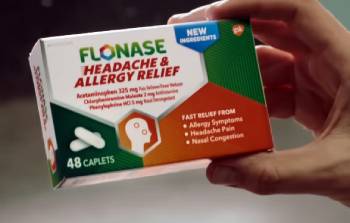If you’ve been dealing with relentless allergy symptoms and headaches that just won’t let up, Flonase Headache and Allergy Relief Caplets might be exactly what you need.
This product is specifically designed to target both allergy symptoms and the head pain that often accompanies them. As someone who’s struggled with allergy season and the pain it brings, I know how tough it can be to find effective relief.
With these caplets, you’re looking at a fast-acting, comprehensive solution to help you feel like yourself again. Let’s look at what makes this product a great choice and how it compares to other options out there.
What is Flonase Headache and Allergy Relief?

Flonase Headache and Allergy Relief is an over-the-counter (OTC) medication designed to provide fast relief for allergy symptoms and sinus-related headaches. Unlike many standard allergy medications, it combines three active ingredients to tackle multiple symptoms at once:
- Acetaminophen (650 mg) – A pain reliever that helps to alleviate headaches, sinus pain, and general discomfort.
- Chlorpheniramine Maleate (4 mg) – An antihistamine that reduces symptoms like sneezing, itching, and runny nose.
- Phenylephrine HCl (10 mg) – A decongestant that works to relieve nasal congestion and sinus pressure.
These ingredients make Flonase unique because it doesn’t just target typical allergy symptoms like congestion and sneezing—it’s also designed to relieve the headache and sinus pain often caused by allergies. This product is suitable for people aged 12 and older, offering a well-rounded approach to both seasonal and year-round allergy relief.
Each dose consists of two caplets, which should be taken every 4-6 hours, with a maximum of 10 caplets in 24 hours. Unlike nasal sprays, which are often limited to nasal congestion, Flonase Headache and Allergy Relief caplets deliver systemic relief for multiple allergy-related symptoms, including head pain.
How These Ingredients Work Together
When combined, acetaminophen, chlorpheniramine maleate, and phenylephrine create a comprehensive solution for allergy sufferers. While the antihistamine component reduces typical allergy symptoms like sneezing and itching, the pain reliever helps alleviate headaches. Meanwhile, the decongestant clears nasal passages and reduces pressure, tackling the full range of allergy-related discomforts.
This multi-symptom relief makes Flonase Headache and Allergy Relief an ideal choice for those dealing with seasonal or environmental allergies that often bring along sinus pain and headaches. With a quick onset time, it can start relieving symptoms within 20–30 minutes, providing fast, dependable relief.
Also Read: My Thoughts On The Ocean Healed My Eczema
Pros and Cons of Flonase Headache and Allergy Relief

Pros:
- Multi-Symptom Relief: Flonase Headache and Allergy Relief doesn’t just target one or two symptoms; it tackles a range of allergy-related issues. Alongside traditional symptoms like sneezing, itchy or watery eyes, and nasal congestion, it addresses headache and sinus pain, a major advantage for people who struggle with these specific symptoms.
- Fast-Acting: Many users report feeling relief within 20–30 minutes of taking Flonase caplets. The combination of acetaminophen and a decongestant delivers rapid relief, helping alleviate symptoms quickly when allergy discomfort strikes.
- Non-Drowsy Formula: Unlike many antihistamine-based allergy medications that cause drowsiness, Flonase Headache and Allergy Relief is non-drowsy. This allows for daytime use without disrupting work or daily activities, making it ideal for people who want relief without feeling sluggish.
- Ease of Use: The caplets are easy to swallow, making them convenient for people who prefer tablets over nasal sprays. The blister packaging also makes it easy to carry a few caplets on the go, whether in a bag, pocket, or first aid kit.
- Trusted Brand: Flonase is a well-established name in the allergy-relief category, known for effective and high-quality products. Many people already trust the Flonase brand, especially those who have used its nasal spray products.
Cons:
- Shorter Duration of Relief: Unlike 24-hour nasal sprays, Flonase Headache and Allergy Relief caplets need to be taken every 4–6 hours, with a maximum of 10 caplets per day. This can be inconvenient for those who prefer once-a-day medications.
- Potential Side Effects: Although it’s non-drowsy, some users may experience mild side effects, such as mild stomach upset or restlessness due to the decongestant (phenylephrine). In rare cases, some people may also feel slightly jittery.
- Not Suitable for Everyone: Because it contains acetaminophen, chlorpheniramine, and phenylephrine, people with certain health conditions (like high blood pressure or liver issues) should avoid this product or consult a doctor before use. It’s also not suitable for children under 12.
- Limited to Temporary Relief: This product is designed for symptomatic relief rather than long-term management of allergies. People with severe, chronic allergies may require additional or alternative medications to address underlying issues.
- Can Be Overlooked for Full Allergy Relief: Since Flonase is well-known for its nasal sprays, some people may overlook the caplet option for multi-symptom relief, especially those unfamiliar with the new product.
How to Get the Most Out of Flonase Headache and Allergy Relief

If you’re looking to maximize the effectiveness of Flonase Headache and Allergy Relief caplets, here are some tips based on both my experience and feedback from other users:
- Take It Right When Symptoms Start: The sooner you address your allergy symptoms, the better. If you start experiencing a headache or congestion, don’t wait for things to worsen. Pop two caplets at the first sign, and you’ll likely find relief faster.
- Stay Within the Recommended Dosage: It might be tempting to take more if symptoms persist, but sticking to the recommended limit of no more than 10 caplets per day is crucial for your health, especially for liver safety. Overuse of acetaminophen, one of the active ingredients, can lead to liver damage over time.
- Pair It with Nasal Sprays if Needed: While the caplets work well for most people, you can also use Flonase nasal sprays to further control congestion. This combination can provide extra relief, particularly on days when pollen levels or other allergens are high.
- Hydrate: Staying hydrated helps reduce dryness and irritation in the nasal passages, which can amplify your allergy symptoms. Water supports your body in fighting off allergens, so drink plenty to keep everything functioning smoothly.
- Monitor Your Symptoms: Not every allergy or headache treatment works the same for everyone. Keep track of your symptoms and responses so that you can find the timing and dosage that works best for you within the safe guidelines.
Flonase Headache and Allergy Relief Vs. Other Brands
- Flonase Headache and Allergy Relief Vs. Claritin-D
Claritin-D is another popular option for allergy relief. It combines loratadine (an antihistamine) with pseudoephedrine (a decongestant). While it’s effective for allergy relief, it doesn’t directly target headache pain like Flonase does. Users may need to add a pain reliever if headaches are a big issue, making it less convenient for multi-symptom relief.
- Flonase Headache and Allergy Relief Vs. Zyrtec-D
Zyrtec-D offers similar ingredients to Claritin-D but is known for its effectiveness against persistent allergies. Like Claritin-D, it may require a separate pain reliever to address headaches, so it might be better suited for those who only need allergy relief.
- Flonase Headache and Allergy Relief Vs. Advil Allergy and Congestion Relief
Advil’s formula includes ibuprofen for pain relief, chlorpheniramine maleate as an antihistamine, and phenylephrine HCl as a decongestant. This product is more similar to Flonase, with the added benefit of ibuprofen’s anti-inflammatory properties. However, ibuprofen isn’t always ideal for everyone, particularly those with sensitive stomachs. Flonase, with acetaminophen, is generally gentler on the stomach.
- Flonase Headache and Allergy Relief Vs. Benadryl
Benadryl is a common choice for allergies, but its strong sedative effect makes it less ideal for daytime use. While effective, Benadryl can make users drowsy, so it’s better for nighttime use rather than a non-drowsy, daily option like Flonase.
Frequently Asked Questions (FAQ)
No, Flonase Headache and Allergy Relief caplets are formulated to be non-drowsy, allowing you to stay alert and active while managing symptoms. Unlike some other allergy medications, it won’t interfere with your daily routine.
Yes, Flonase Headache and Allergy Relief specifically targets headache pain along with allergy symptoms. The acetaminophen in the caplets provides pain relief that’s effective for allergy-related headaches and sinus pain.
Flonase contains phenylephrine HCl, a decongestant that may raise blood pressure slightly in some individuals. If you have hypertension or concerns about blood pressure, consult your doctor before use.
It depends on when your symptoms are most intense. The non-drowsy formula allows flexibility; take it whenever symptoms arise, whether in the morning or at night. Some users find it helpful to take Flonase in the morning to stay symptom-free throughout the day.
Final Thoughts
If you’re tired of juggling multiple medications to treat allergy symptoms and headache pain, Flonase Headache and Allergy Relief caplets could be a game-changer. With just two caplets, you’re tackling everything from nasal congestion and sneezing to that pounding headache. It’s fast-acting, convenient, and easy to take. As someone who’s tried multiple allergy products, Flonase stands out for its multi-symptom coverage and ease of use. Give it a try, and you might just find your new go-to allergy solution!



